#for shark population decline
Text

Anyway they won’t allow comments OR reblogs (my guess is so they can stay in their echo chamber and so they don’t have to own up to spreading misinformation) so I’m going to debunk this misinformation here on my own post.
Sharks are, in fact, NOT on the verge of extinction, that is clear by a simple Google search. Certain sharks species are ENDANGERED or VULNERABLE which has nothing to do with JAWS and everything to do with the fishing industry. Of course because they are endangered and vulnerable they RISK extinction in the future but they are not 'on the verge' of it.
List of endangered and vulnerable shark species
Sharks, rays, and similar species are killed NOT because of an American movie but because of overfishing of sharks. In certain cultures, shark fin soup is said to be medicinal and provide a wide range of health benefits. Despite no evidence of such being true, certain cultures still fish for sharks for their fins alone. This is deadly because of the way sharks breathe. They need to be in motion in order to breathe and without their fins they slowly suffocate to death.
Source of why sharks are currently endangered
Last, lets finally bring up JAWS and why this argument doesn't prove the point of "fiction can affect reality" in the way they think it does. JAWS causing people to be more afraid of sharks did NOT cause shark-finners and shark overfishing to occur or get worse. The "JAWS effect" doesn't actually exist in any meaningful way beyond people from the USA being more afraid of sharks. JAWS did not have that much of an impact in other parts of the world where shark fishing is common. Of course the movie JAWS DID inevitably lead to people killing sharks, but not nearly to the scale most assume. Shark-fishing tournaments were set up and fishermen at the time would catch as many sharks as they could. This did lead to a big decline of sharks in the US east coast due to the overfishing. Keep in mind that this, however, does not account for the millions of sharks killed for their fins every year.
Did JAWS have an impact on the way people (especially in English-speaking countries) saw sharks? Yes it did, the uneducated masses at the time had no idea how sharks actually functioned. Did JAWS cause a decline in shark populations in the US? Yes it did, fishing contests put in place greatly affected the sharks in the East coast of the US. Did this have a greater impact on shark populations as a whole and their decline? Nope! The biggest reasons sharks are endangered as they are now is because of overfishing, shark finning, and bycatch (catching a fish and then discarding it because it isn't the fish you desired/can sell).
Link 1 about the "JAWS Effect" myth
Link 2 about the "JAWS Effect" myth
#jaws effect#debunk#drama#discourse#proship#anti proship#for reach#y'all need to read this#and focus your efforts#on stopping the real reasons#for shark population decline#worldwide
124 notes
·
View notes
Text
realizing that the fiction affects reality crowd attributes negative affects of broad cultural and societal issues to fiction which diminishes the reality of the issue and fails to address the underlying root of these problems which is, dare I say, conservative asf.
#Video games cause violence jaws causes shark population to decline rage by Steven king caused a school shooting etc#fiction
5 notes
·
View notes
Note
do the sharks in your universe go through parthenogenesis? if they do, do they have control over the pregnancy or does it happen at random?
That's a very interesting question!
I thought about it and yes, parthenogenesis happens to the sharks in my universe. One of the characters, the zebra shark called Aria, is the fruit of parthenogenesis.
As for the cause, even for our science today, it is still unknown how this works or whether the female shark has control over it in any way. It is not known whether the females trigger the phenomenon or whether it happens spontaneously. I haven't found much information either; it's something very new to us. Recently, a stingray in captivity became pregnant by parthenogenesis, for example. Stingrays belong to the same family as sharks.
As there are few answers at the moment, I decided to take inspiration from a fantasy idea about this. What I'm going to tell you now is a fictional vision of the origin of parthenogenesis:
My shark people theorize that parthenogenesis is a kind of "Shadow of Decline", an ancestral ability inherited by female sharks that withstood mass extinction events in the primordial ages of the planet.
They theorize that there were probably times when the male shark population declined, so the females who were able to adapt to create "backups" of their genes through cloned daughters prevailed, while those who lacked this adaptation became extinct.
In short, they theorize that females, in situations of stress and prolonged absence of male sharks, trigger a clone as a type of genetic reserve. As she gets older, she transfers the responsibility to her cloned daughter, who may have a better chance of finding a partner to pass on her genes and ensure the survival of the species.
In the context of civilization, the conditions for parthenogenesis to take place are still unknown. But my sharks link the phenomenon to a stress response and prolonged life without producing offspring.
Maybe it's not a good comparison, but it would be a kind of menstrual cycle that instead of happening monthly, happens randomly between 10~20 years after sexual maturity. (I used as inspiration a female blacktip reef shark that developed a fetus in her uterus after 10 years of living in an aquarium without the presence of males).
Modern shark society offers full support to females who don't want to go ahead with parthenogenesis and are given full assistance to carry out abortions. But there are also many females who choose to accept the phenomenon, go ahead with the pregnancy and become the mothers of these children, while some females give birth but hand the newborn over to "kindergartens", which act like orphanages/schools/universities that provide full support for the child to grow up and become independent or be adopted.
A reminder that children born from parthenogenesis will always be girls and with identical genes to their mother. Because of this, some females are afraid to go ahead with parthenogenesis, as they fear that their daughters will suffer from the same physical or mental health problems as their mothers.
In the case of zebra shark Aria, her mother has a neurodivergence and she feared that her daughter would suffer as much as she did, but she decided to go ahead with her daughter's parthenogenesis. Despite having the same neurodivergence, she views it with a completely different approach to her mother, which gives her hope and support.
That's it! I'm sorry if I've written too much or if my English is strange, I got carried away, maybe I'm missing more details, but that's what I've thought so far. Any other ideas to enrich this would be welcome!
It's a very interesting creative exercise to imagine how parthenogenesis would be viewed in a civilized society like ours.

308 notes
·
View notes
Text
Animal of the Day!
Greenland Shark (Somniosus microcephalus)
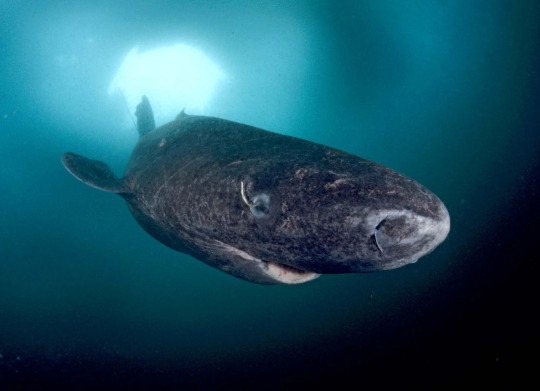
(Photo from Britannica)
Conservation Status- Vulnerable
Habitat- Northern Atlantic; Arctic Ocean
Size (Weight/Length)- 4 m
Diet- Fish; Seals; Small whales
Cool Facts- The world’s oldest Greenland shark may have witnessed the first European boats making their way across the Atlantic to reach the Americas. It is estimated that Greenland sharks can live anywhere from 250 years old all the way to 500. They are extremely slow growing, most likely due to the freezing waters they live in. These sharks are not sexually mature until they turn 150 and a pregnancy can last up to 18 years. They are slow moving, apex predators, targeting sick or sleeping animals which can include moose or caribou swimming between islands. Unfortunately, Greenland sharks are killed for their flesh that is considered a delicacy in Iceland. Overhunting, bycatch, and an extremely slow generation time are the leading reasons for the decline of Greenland shark populations.
Rating- 12/10 (Most of what we know about them is conjecture.)
#animal of the day#animals#sharks#marine life#marine biology#friday#january 5#greenland shark#biology#science#conservation#the more you know
219 notes
·
View notes
Text
It feels less like you want to address a real life problem to characters, but more like you want to have another of your characters you constantly baby and want others to fangirl over.
TW: Rape, SA, Racism, Stereotyping, Homophobia, Acephobia, Arophobia.

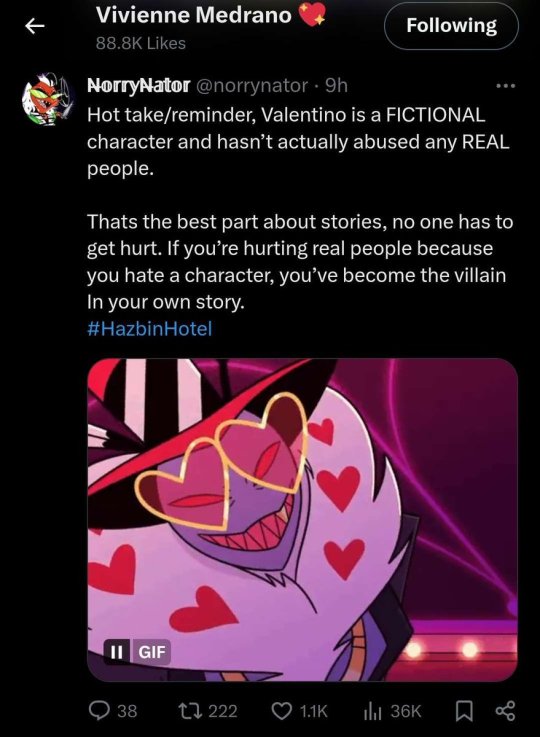
The representations of topics in media DOES affect real people.
Fiction can affect reality.
Let's start easy, Jaws. This goes back to Hazbin I promise.
"Since the release of Jaws in 1975, the world has witnessed a staggering decline of 71% in shark and ray populations, and around 100 million sharks are killed each year." (including multiple practices of mass hunting sharks in competition)
Both Steven Spielberg and the original writer Peter Benchley regret the movie and book. It's a big reason of the shark treatment, when it started by old fishermen worrying about shark biting people in the beaches they made money of.
Even if you aren't a shark killer yourself, a lot of things you believe of sharks are untrue myths that come from making sharks "evil" human killer animals. Sharks cannot smell blood from miles away, that's not even how water works, the particles of blood need to enter their nostrils. Sharks are not man eaters, they attack other prey animals before human. Shark attacks are extremely rare, even if they happen they are not justifiable to kill all sharks.
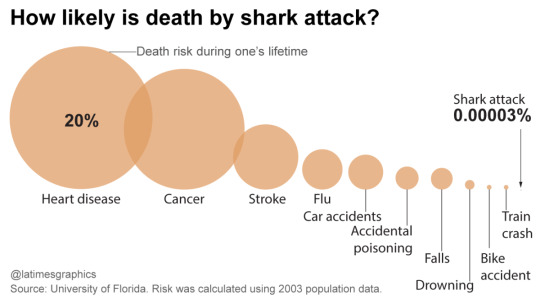
Sharks actually have personalities they can fit in, they are smart and recognize people and boats- and form positive relationships with people. They can even like getting pet by people.
youtube
youtube
Other level to represent other thing sin media that affects reality we can address Queer, representation as a topic.
I hope it is not a surprise for you... possible non-straight, non-cis person reading this. That the constant representation of gay man as kid predator is a problem. They used old commercial (PSA) to spread negative views of gay man. Media is used to spread messages and affect its viewer. This is, there are cartoons created by Jehovah witness (or similar religions) to spread their beliefs and teach to their children in an easy, digestible way.
Same with the amount of straight woman that went off to read shitty yaoi manga and fetishy gay wattpad stories, and went to sexualize and diminish queer men. Constantly making gay man's personality into bottom or top (uke and seme shit). I witness this irl, others have too.
Same with shitty men that view Lesbians as a porn machine for men, cause "monkey brain like woman, lesbian = two women". Which happens in general and adult media. All of these are EASY examples.
Another one which turns out many people don't think about. Having your representation of an AroAce character (on purpose or not) be the psychopath with no feelings. Associating the not being romantically or sexually to means you have no heart, to be abnormal, by then a psychopath. An abuse or serial killer.
Fiction does affect reality-
A racist film, 'Birth of the nation' Revived the KKK and let to all the discrimination, and the homicide of black people of centuries ahead.
youtube
-
Coming back around, how you treat the topic of SA, and r-pe- affects the real world. You would think someone who wrote that, had in mind on how that affects people in real life. Didn't you want to represent victims of SA/R-pe that are sex workers and male?
Reducing the r-pist, pimp, trafficker character to an air head to treat as silly is crazy to do. Specially as... oh idk... the creator? Both this and the tweet of the voice actor calling Val "Bubbles Coded" is so crazy. The character is also not deep enough by itself, it's pretty much Stupid and a R-pist sex trafficker. The tweet below Viv's fucking kills me too.
The fact Val is shown to be air head stupid doesn't delete he backed Angel (and by being a sex trafficker and a pimp, and him licking charlie that means he has multiple victims) into a corner and under his control. Too then abuse of him in many different ways. Manipulations are not only done by Super mastermind people, and representing it in such way diminished, affects people who have being manipulated and actually try to question if they have being or not. Manipulators can be normal, average people, they usually are not obvious. Even if Val is openly a shitty person that's really obvious, it doesn't detract from him being manipulative to people. The scene where Val threatens him in chains that is manipulation, his text messages are manipulation (even if you think it is too obvious to be successful).

How you represent SA/R-PE, and its perpetrators, do affect real life.
Going around and having your "serious R-pe episode", to then go in other episodes or the other series you are writing to make r-pe/sa jokes is terrible. For the person that directed the whole scene of poison to NOT be r-pe/sa victim (said by themselves) with a r-pe fetish with this character's in specific, to directed in the most graphic way possible is awful. To go around babying your r-pist character is crazy.
youtube
Hope you understand that this doesn't mean not treating any topic at all. Creators should be awere on how they treat topics and the scenarios they create with them, too. People and viewers need to also put their brain to understand the media they consume. But you can't always put all blame only on the viewers of a series, if media is messy is a fault of the media. You can criticize both.
You need to acknowledge Valentino is indeed a terrible person, You don't need to delete his actions or the weight of them.
I also just know that a lot of Val fans just like him to draw him in r-pe art and get their fetishized gay ship. Cause that's what they are into. You won't even do that with a woman, because you are into your fucked up fetishized gay porn from wattpad you never left behind.
If you like him, FUCK IT, just please take his abuse seriously. Don't default your entire usage, and view of the character to be 'uwufied' fandom stuff, please.
I hate how the topic has being treated, in and out of the show. I'm a victim, and I'm hurt by how these things are treated and knowing how it affects others. Even in things I haven't watched! Don't make the argument don't like it? Just don't watch it. The movies from the video of SA of men being a joke, many I haven't watch- that still affects over all. It's still a problem and it's disheartening.
Also have this:
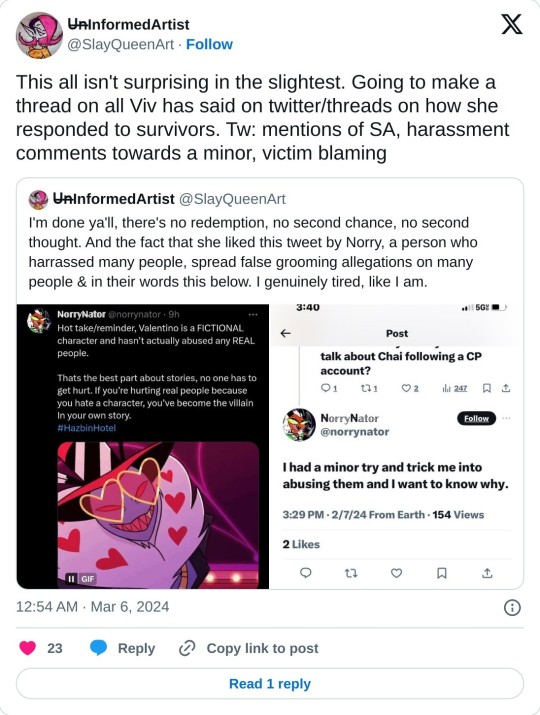
#hazbin critical#hazbin hotel criticism#hazbin hotel critical#hazbin hotel critique#vivziepop critical#vivziepop criticism#vivziepop critique#tw sa#tw rape#tw homophobia#tw racsim#tw acephobia#tw arophobia
138 notes
·
View notes
Note
i wasn't baiting u. seriously i've been reading up on shit and to deny fictions effects is to deny reality. jaws caused the shark decline. rosemarys baby caused the satanic panic. this is common knowledge
ok. this is incorrect in regards to the specific cases you cite and incorrect in general in regards to the outsize causal role you attribute to media products in cultural phenomena. it is fundamentally unserious to assert that the film jaws is 'the' cause of shark population declines when killings of sharks by humans occur the vast majority of the time for reasons like the use of industrial fishing nets; global populations of many animals have declined since jaws for reasons similarly economic and wholly unrelated to it; and people feared sharks long before the release of jaws and have instituted legal protections for the great white, in particular, since then. it is similarly unserious to assert that the film rosemary's baby is 'the' reason usamericans in the 1980s fear-mongered about secret satanic cults committing ritual child abuse when this was a myth deeply useful in shoring up the legal and social power of parents; was copacetic with an overall pro-cop law-and-order attitude picking up steam for many reasons including the wake of the civil rights movement; and was never even believed by most people because it appeared outlandish. again the broader stance here (that media can or has singlehandedly caused massive cultural phenomena arising de novo from those works) is simply an indefensible argument. where do you think these narratives arise from in the first place? what makes them coherent, compelling, and possible to parse as meaningful for audiences? i would suggest reading up on some basic tenets of the base/superstructure relationship and start questioning narratives that make tidy and emotionally compelling arguments about film as an omnipotent and unilateral engine of social change without considering other explanations for the phenomena and data in question, or the factors that lead to the production of cultural artefacts like films in the first place.
134 notes
·
View notes
Text
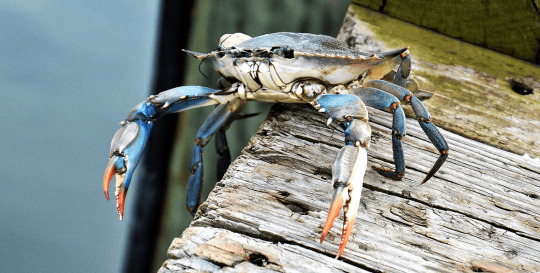


At Last, the Atlantic Blue Crab!
A common sight on dinner tables in Canada, America, and Mexico, the blue crab-- also known as the Atlantic blue crab or the Maryland Blue crab (Callinectes sapidus)-- is native to the the Gulf of Mexico and the Atlantic coast of North America. This species is a bottom dweller, and can occupy a range of habitats from freshwater tributaries to the open bays and gulfs of the ocean itself. At times it may be found at high tide, but most individuals remain submerged at depths up to 36 m (120 ft) deep.
As indicated by its name, the claws and front body of male blue crabs are bright blue. Females are carry a blue tinge, but are largely brown or olive, though the tips of their claws are bright red. Otherwise, the two sexes may be distinguished by the shape of their underside, or "apron"; males have an inverted 'T' shape, while females have a wider, rounder shape. Individuals of both sexes may grow up to 23 cm (9 in) in width, and weigh up to 136 g (0.3 lbs).
Spawning for C. sapidus can occur year-round, but for most populations it peaks in October or November. When females are ready, they travel up estuaries and rivers to where populations of males are more concentrated, and then release pheromones in their urine to attract mates. Male crabs then compete for access, and guard their chosen mates fiercely for up to a week. During this time, the female molts, at which point the male fertilizes her. Afterwards, she may retain her mate's sperm for up to a year, during which time she returns to saltier waters. A female can fertilize 2 million eggs at a time, and will carry them in a mass under her abdomen until they hatch, about a week after fertilization. She may do this as many as 4 times throughout a single mating season.
Once hatched, Atlantic blue crab larvae are released into the ocean. Each larvae spends 30-40 days going through seven larval stages known as zoea; these stages are similar to the instars of a larval insect. However, zoea have hard shells and must molt at each stage of development. After the initial zoea stages, juvenile C. sapidus enter the megalops stage, which lasts 6-20 days. During this time juveniles move from the ocean into the estuaries in which they spawned. Finally, they molt into their final form, which resembles an adult-- albeit much smaller. Both males and females continue to molt throughout the year until they reach their full size. In total, both sexes go through about 25 molts each throughout their lives, which spans about 3 years in the wild.
Blue crabs have a wide and varied diet, as they are omnivores. In their larval stages, Maryland blue crabs consume primarily plankton and detritus. Megalops and adults will feed on clams, mussels, and oysters, small fish, kelp, seaweed, carrion, smaller blue crabs, and animal waste. In turn, both juveniles and adults are food for eels, large fish some sharks, stingrays, and humans. In fact, predation upon larval and sub-adult blue crabs is so heavy that, of 8 million eggs released by the mother, only 1 or 2 typically survive to adulthood.
Conservation status: The Maryland blue crab has not been evaluated by the IUCN. However, in recent decades, fisheries have noticed a severe decline in abundance, likely due to over-harvesting and pollution.
If you send me proof that you’ve made a donation to UNRWA or another fund benefiting Palestinians– including esim donations and verified gofundmes– I’ll make art of any animal of your choosing.
Photos
Kim Cover
Lynn Strauss
Jo O'Keefe
#atlantic blue crab#Decapoda#Portunidae#swimming crabs#crabs#decapods#crustaceans#arthropods#marine fauna#marine arthropods#coasts#coastal arthropods#atlantic ocean
92 notes
·
View notes
Text
It's Wet Beast Wednesday and this week's topic is Sphyrna tiburo, the bonnethead shark. This is a small and wildly adorable species of hammerhead shark that has some very unique features not found in other sharks.

As with most sharks, females are larger than males, reaching an average of about 0.7 to 1 meter (2.3 - 3.3 feet) in length with the longest recorded specimen being 1.5 meters (5 feet). They live in shallow waters, preferring to live in seagrass beds and muddy or sandy sediment. They are found on both coasts of the Americas in warm seas, though they can be found as far north as New England or northern California in rare cases. They migrate south during the winter. Bonnetheads are social and usually live in groups of 5 - 15 members, but can occasionally school in the hundreds or thousands, usually during migration. Scientists have identified at least 18 social behaviors, often used to display dominance or compete for mates. Bonnetheads are very timid and flee from humans. Only one attack on a human has been recorded and it left minor injuries.
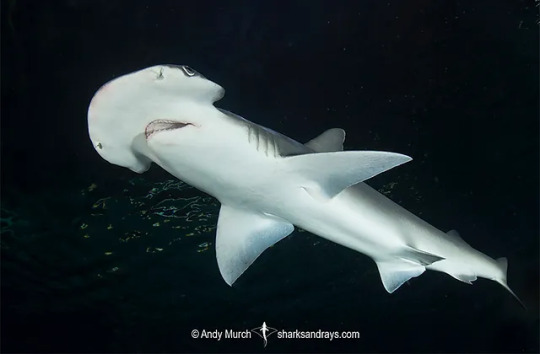
One of the unique features of the bonnethead is the fact that they are the only shark species to have sexual dimorphism of the head. Sexual dimorphism is when the males and females of a species have distinct physical features. This is common with sharks, with males usually being smaller than females and having distinct reproductive organs known as claspers. Bonnetheads have an additional dimorphic feature on the cephalofoil (that's the hammer head of the hammerhead sharks). Females have a smooth cephalofoil while males have a distinct bulge on the back edges. in addition, the cehalofoil of the bonnethead is smaller and more rounded than in other hammerheads. Other hammerheads don't use their pectoral fins very much and rely on using their cephalofoil to achieve pitch (up and down movement) and yaw (side to side movement). Because bonnetheads have smaller cephalofoils, they must rely on their pectoral fins more than other hammerheads, and theirs are therefore proportionately larger and stronger than the fins of other hammerheads. By hammerhead standards, the bonnethead is the guy with massive biceps.

The other major unique feature of bonnetheads is their diet. Bonnetheads eat mainly crustaceans, molluscs, and small fish, but also eat a large amount of seagrass. this makes them the only omnivorous sharks, with all others being strict carnivores. Scientists thought that the seagrass was used to protect their gut from shark shells, but recent studies have shown that they do actually digest around 50% of the seagrass and have enzymes in the hindgut that can break down cellulose, implying they do gain nutrition from seagrass.

Bonnetheads are one of several shark species capable of asexual reproduction. A female at the Henry Doorly Zoo in Nebraska produced a pup through through parthenogenesis. The pup's DNA was identical to the mother's. Bonnetheads also have the shortest gestation period of any shark at only 5-6 months and give live birth.

Bonnetheads were once classified as "Least Concern" by the IUCN. this led to it being highly targeted in fisheries, both commercial and recreational. In 2020, it was reclassified as "Endangered" due to massive population declines in the Caribbean, Central and South Atlantic, and most of their Pacific range, largely due to overfishing. As of late 2021, the IUCN now considered them the be "Largely Depleted, meaning their population is currently much smaller than it was historically.

#wet beast wednesday#fishblr#fish#shark#sharks#bonnethead shark#hammerhead#ecology#zoology#marine biology#very cute shark
521 notes
·
View notes
Text
Date: March 28, 2023
Source: Yale University
Summary: Solving the climate crisis and biodiversity crisis are not separate issues. Animals remove billions of tons of carbon dioxide each year. Restoring species will help limit global warming, new science reveals.
The study, published in Nature Climate Change and co-authored by 15 scientists from eight countries, examined nine wildlife species -- marine fish, whales, sharks, grey wolves, wildebeest, sea otters, musk oxen, African forest elephants, and American bison. The data shows that protecting or restoring their populations could collectively facilitate the additional capture of 6.41 billion tons of carbon dioxide annually. This is 95% of the amount needed every year to meet the Paris Agreement target of removing enough carbon from the atmosphere to keep global warming below the 1.5-degree Celsius threshold.
"Wildlife species, throughout their interaction with the environment, are the missing link between biodiversity and climate," Schmitz says. "This interaction means rewilding can be among the best nature-based climate solutions available to humankind."
Wild animals play a critical role controlling the carbon cycle in terrestrial, freshwater and marine ecosystems through a wide range of processes including foraging, nutrient deposition, disturbance, organic carbon deposition, and seed dispersal, Schmitz's research has shown. The dynamics of carbon uptake and storage fundamentally changes with the presence or absence of animals.
Endangering animal populations to the point where they become extinct could flip the ecosystems they inhabit from carbon sinks to carbon sources, according to the research.
The world's wildlife populations have declined by almost 70% in the last 50 years. The study shows that solving the climate crisis and biodiversity crisis are not separate issues and the restoration of animal populations should be included in the scope of nature-based climate solutions, the authors say. Rewilding animal populations to enhance natural carbon capture and storage is known as animating the carbon cycle.
Read more.
547 notes
·
View notes
Text
6.17.2024: The Big Snooze
On June 17th, 2024, something odd began to happen.
The newest SPECTRE hench, who had been fetching coffee, returned to find the entire organization asleep, many clutching guns and knives like teddy bears.
(Carefully disarming people was the hench’s official first task after the coffee. The second was setting up an automatic feeder for the sharks with laser beams attached to their heads.)
Attempts to make contact with other crime organizations (the Unione Corse, SMERSH, SHAPE, DARE) proved largely fruitless. Even hitter.com, the villainous social network, had dwindled to about three active hitter threats about the situation.
Meanwhile, the latest Q Branch intern, who had been fetching more C4, almost dropped their plastique when they returned to find the entire branch kipping on desks and work cots. They ran to find help and soon discovered the entire MI6 population, including administrative staff, off-duty workers, and even 00 agents, all in the same position: asleep. Safe, but asleep.
Asleep at work, asleep in their beds, and in some cases asleep in someone else’s bed.
Attempts to make contact across the pond revealed that the only person available to answer the big red emergency phone was a harried janitorial worker. Casebook.com, the intelligence agent networking site, showed timelines that had gone silent.
(Other parts of the government ran as usual, and in fact the number of, e.g., overturned tomato carts due to marketplace chases immediately declined.)
Across the globe, the story was the same: intelligence agents, villains, and support staff had begun to feel sleepy…then decided to take a nap…then could not be roused. No major or minor player on the active duty rosters was excluded.
Retired medical staff who hadn’t yet left Britain for the warmer climes of their choice came in and confirmed that everyone’s vital signs were normal aside from being unable to wake.
In the aftermath, a ragtag group of people came together at two stations across the globe, Station Atlantic and Station Pacific. Their mission: to try to 1) prevent global catastrophes, and 2) solve the mystery of the sleeping spies.
There is a brief lull as everyone adjusts to the new state of affairs, but remaining experts (octogenarian Nelly, who has sixty years of experience and can feel these things in her bones) suggest that the two stations will face their first challenge starting on July 1st.
How successful will these stations be?
Let’s find out during 007 Fest 2024!
38 notes
·
View notes
Text
Amphibian Perucetus and giant scissor sharks
In previous posts, we considered Moropiton and Poseideongenia, two groups of animals that migrated to Siberia through the Ural Sea in the Late Carboniferous. Before moving on to the actual descendants of these Seymouries - the Angarians themselves - we can distract ourselves with the creatures that the Moscow settlers could encounter on a vegetable raft.

The Dynasty of marine amphibians
Let's start with a strange speculative kind that shouldn't exist. Ichthyocetus, the "whale fish", is a large animal reaching a size of up to 2.5 meters and is a direct descendant of tetrapods of the Moscow Sea, primarily tulerpeton. The latter is known primarily for its six-toed limbs developed relative to other modern tetropods, as well as for its location. The fact is that the remains of the tulerpiton were located 200 kilometers from the supposed shore: this and the very structure of the body of the tetrapod under discussion suggest that the animal lived in shallow water, breathing atmospheric air (no bones corresponding to the gills were found, and the head was separated from the body - i.e. the tulerpeton could lift its head) and moving forward using the legs, pushing them off the bottom (their strength would not be enough to allow the toolerpeton to move on land). It is possible that some tetrapods could have stayed in this habitat, becoming the main predators of shallow waters, where larger predators like eugeneodonts or placoderms could not move normally.

Tulerpeton, 360 m.y.a. Art by Dmitry Bogdanov

Tulerpeton found fossils
Ichthyocetus is the last representative of this hypothetical clade, whose population was almost completely destroyed by the decline in sea level due to the new peak of the Karoo ice Age. His basic diet is benthos, which he can find in the buried ground: echinoderms, starfish and lilies, as well as, if luck smiles, the corpses of marine animals that the surf brings. He could also purposefully hunt for moropitons if they swam too deep. The bones of ichthyocetus are incredibly dense; this allows it to stay in the water during strong waves. This animal is able to sense the approach of a storm - then it tries to find the shore and crawl out onto it, burrowing into the sand; then they are most vulnerable. If it is impossible to find the shore, then the ichthyocetuses go to depth, swallowing air, where they can stay for 3-4 hours. Sometimes this tetropods go deep in search of new food sources, where they can catch young eugeneodonts or small fish. Surprisingly, ichthyocetuses are not the largest representatives of their clade (let's call it Ichthyocetusae): some species could grow up to 3 meters and lead a more pelagic lifestyle.
They usually appeared during periods of intense glaciation with a reduction in their original habitat. Unfortunately, this time climate change has become insurmountable.
Something about scissor sharks
If the meeting of protoseimurians with their "cousin" was unreliable, then the same cannot be said about eugeneodonts. The largest animals of the sea were the edestus, or protopirates. Although the largest protopirate species, E. vorax, could reach 6 meters (making it the largest predator of its time), the Moscow species were somewhat smaller and reached a maximum of 4 meters. These sizes correspond to the modern white shark and mako shark.

Edestus, 313—307 m.y.a. Art by Dmitry Bogdanov

Comparison of the four species of Edestus. Authors of this illustration is Leif Tapanila and Jesse Pruitt
Both poseideonogenes and moropitons encountered these cartilaginous fish - most likely, they were four-meter E. heinrichi and E. triserratus commensurate with ichthyocetus. Most likely, the edestus hunted numerous nautiloids and other soft-bodied prey and could well attack rafts, mistaking them for a dead cephalopod with a spiral shell. The protoseimuria themselves would not be of interest to the edestus - they are too small. That's what saved them.
#original species#spec evo#spec bio#speculative biology#speculative zoology#artists on tumblr#paleoart#art#paleontology#paleozoic
51 notes
·
View notes
Text
Shark Dump: Lemon Sharks!
Some of you seemed to enjoy my shark facts and honestly, if I can get the chance to rave about sharks, I will. So here are some shark facts starting with my favorite, Lemon Sharks!!
If you guys enjoy this, feel free to leave me a request with the name of a shark you'd like to learn about and I'll be happy to info dump on them. I'm thinking about posting one every Sunday (Shark Sundays!!! :D )
Technically I was supposed to post this earlier but I didn't lol oops-
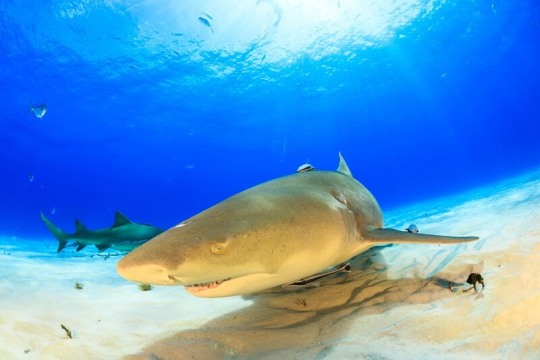
Conservation Status: NEAR THREATENED
This cute guy here is a Lemon shark or Negaprion brevirostris! They get this name from their yellowish skin and yellow bellies but they can be anywhere from brown to olive colored. Lemon sharks are mostly native to the Atlantic Ocean and parts of the Pacific where they occupy coral keys, mangrove forests, bays and even docks. Most populations can be found in Gulf of Mexico, the West Indies, and the Caribbean.
They can grow up to 11 ft long which makes them one of the larger species of sharks but don't let their size scare you! These guys are mostly scavengers that hunt for food near sandy in-shore areas. Most of the lemon sharks diet consists of bony fish, crustaceans and stingrays although they occasionally snack on seabirds or smaller sharks. They hunt using electroreceptors on their nose, called ampullae de Lorenzini, which help them detect fish and other creatures, even buried in the sand.
(Remember, sharks don't have hands so they rely on their nose and mouth to explore the enviroment around them!)
Lemon sharks usually live in oceanic waters that are no deeper than 188 ft although some have been found in waters at depths of up to 300 ft. They are one of 43 sharks that can swim in freshwater but usually don't travel very far into these waters as they can't survive for long periods in them. If you see a lemon shark in freshwater, they're probably just there for a quick bite to eat before heading back to the ocean.
Fun Fact: Bull sharks are the only shark that can survive in both salt and fresh water! They're also one of the dumber sharks and will try to eat anything that fits in their mouths.
Despite how scary they look, lemon sharks are actually a favorite among divers and marine biologist because of their docile behavior! They rarely attack humans (As of 2011, researchers had found only 10 cases of lemon sharks attacking humans, and none of these cases were deadly), in fact, they are very shy and usually try to avoid us. Though if they do approach, they're usually just being curious and will bump you with their nose.

But my favorite thing about lemon Sharks? Once they get over their shyness, they LOVE getting belly rubs! They find the sensation very pleasant and will actively seek out the divers who pet them, even chasing other sharks away if they feel the diver’s giving them too much attention. Sometimes, if you rub their belly too much or if you stimulate the tiny sensory pores located on their snout, you can put them into something called tonic immobility.
Tonic immobility is a reflex that causes a temporary state of inactivity in an animal. Similar to hypnosis! Researchers aren't sure why sharks do this as it's usually thought to be a prey instinct so apex predators like sharks shouldn't have this. But most researchers have found that the sharks aren't stressed when they perform this behavior so it might just mean they're really relaxed! This is backed up by the fact that when in this state the shark’s muscles relax and their breathing becomes deep and rhythmic. Sharks usually enter tonic immobility in less than a minute and they can remain in this state for up to 15 minutes. It doesn't hurt them at all and researches use this to help subdue them.
Lemon sharks (like many other sharks) are imperative to keeping our reefs alive and healthy. Without them, we've already begun to see a major decline in coral reefs and seagrass beds. By taking these sharks out of the coral reef ecosystem, there's nothing to keep the larger predatory fish in check and they overfeed on the herbivores. With less herbivores, macroalgae expands and coral can no longer compete, shifting the ecosystem to one of algae dominance causing the reefs to eventually die out.
Now, back to lemon sharks and the most important fact I have about them: their conservation status.
Lemon sharks are considered to be near threatened. This means that they are likely to become endagered in the near future. This is because they are targeted by commercial and recreational fishermen primarily due to their highly prized fins. Their meat is also in high demand and is considered a delicacy in many areas. Further, the continuing destruction of their habitat has led to the severe decline of lemon shark populations.
But thankfully, there are steps already being taken to help protect these sweet sea puppies. The Florida Fish and Wildlife Conservation Commission prohibits the harvesting of lemon sharks in state waters. Any lemon shark that catches onto a hook is to be released immediately, either by removal of the hook from the shark or by cutting the shark free—whichever will release the shark quickest. Some countries are also slowly starting to put in protections for them as well.
You can also help! Many people view sharks as blood-thirsty monsters due to decades of slander campaigns and hollywood scare movies (I'm glaring at you Jaws). But we can change that view by showing the world just how beautiful and intelligent these creatures really are! The more informed people are about the sharks, the more we can do to help them. Just by reading this post and learning about lemon sharks, you're helping! Now, the next time you hear someone talking smack about sharks, you can smack them with some cool shark facts! Then hopefully with enough smacking, we can change how people see these lovely predators and get more support for their protection.
#science#marine biology#sharks#shark facts#marine life#lemon shark#conservation#shark conservation#i just love sharks man#sea puppies#that's all they are#sea puppies with very sharp teeth
319 notes
·
View notes
Note
You know I fear for people online when you see takes like “jaws (the movie) contributed to a declining shark population”
I ranted about this before, how a 23 YEAR OLD ADULT made that post and genuinely believed that fiction affected reality this strongly and thousands of people believed it
Today I got a notification that the post got a helpful community note which says “the jaws effect has been debunked and overfishing is generally attributed to a declining shark population”
BUT OF COURSE
NO ONE CARES ABOUT AN OLD MOVIE FROM 1916
...Jaws is that old?
At least somebody finally put the disclaimer that the jaws effect isn't a thing.
#proshippers against censorship#jackal barks#proship please interact#proship positivity#proship#proshipping#proshipper#proshippers please interact#proshipper safe#anti anti#ask#asks#jaws#jaws effect
22 notes
·
View notes
Text
Animal of the Day!
Beluga Sturgeon (Huso huso)
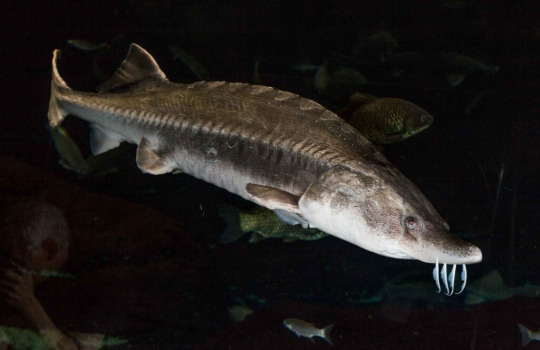
(Photo from the Aquarium of Barcelona)
Conservation Status- Critically Endangered
Habitat- Caspian Sea; Black Sea; Sea of Azov
Size (Weight/Length)- 1500 kg; 7 m
Diet- Large fish; Mollusks; Birds; Crustaceans
Cool Facts- The beluga sturgeon is one of the largest freshwater fish and the third largest bony fish in the world. On an even more impressive standing, the beluga sturgeon rivals great white sharks and Greenland sharks as one of the largest active, predatory fish. Females tend to be much larger than males due to needing more fat reserves for energy while creating eggs. Spending most of their lives in deep lakes, these sturgeons swim upstream to spawn. Females do not reach sexual maturity until 20 years of age and only lay eggs every four to seven years. Sadly, poaching for caviar and meat has dropped beluga sturgeon numbers to dangerous levels. Through conservation efforts, thousands of fertilized eggs and juveniles have been introduced to wild populations yet illegal hunting results in further decline.
Rating- 13/10 (As big as a small beluga whale.)
#animal of the day#animals#fish#freshwater fish#sturgeon#thursday#june 22#beluga sturgeon#biology#science#conservation#the more you know
250 notes
·
View notes
Photo

Greenland Shark (Somniosus microcephalus)
Family: Sleeper Shark Family (Somniosidae)
IUCN Conservation Status: Vulnerable
Found in cold regions of the Arctic and northern Atlantic oceans, the Greenland Shark is best known for its extremely long lifespan: members of this species regularly live to be over 200 years old, with some individuals living for over 400 years. Sluggish and extremely slow when swimming, it is an opportunistic carnivore that will take any sufficiently large prey that comes near enough for it to catch: it feeds largely on squids and smaller fish such as herrings, halibuts and salmon, but on occasion may also eat animals as large as seals, sea lions and dolphins (although as Greenland Sharks have rarely been seen actively attacking marine mammals and are far too slow to catch a healthy dolphin or seal, it is suspected that most of the marine mammals found in their stomachs were already dead when they were eaten - this would also explain the occasional discovery of the remains of terrestrial animals such as Reindeer and Polar Bears in their digestive tracts.) While little is known about the Greenland Shark’s life cycle, it is believed that they reproduce rarely and take a considerable amount of time to do so - current estimates (based on the development and estimated age of various adult and juvenile Greenland Sharks caught by fishers) suggest that they take over 100 years to reach sexual maturity, and upon successful mating their eggs (which develop and hatch inside their mother’s body) take a further 8-18 years to hatch. Greenland Sharks are frequently caught by fishing vessels (both deliberately to be eaten or for their livers, the oils of which are sold as having medicinal properties, and accidentally as by-catch), and this practice combined with the very slow rate at which they repopulate due to their extremely long generation length has caused concerning declines in populations of this species in recent years. The high concentration of the compound Trimethylamine N-oxide in the organs, fat and muscles of the Greenland Shark (which aids the shark’s tissues in enduring intense cold) means that the flesh of this species is poisonous to most animals if not first dried or fermented.
----------------------------------------------------------------------------
Animal Advent Calendar - Day 5
Image Source: https://www.inaturalist.org/taxa/180001-Urocitellus-parryii
#december 5th#greenland shark#shark#sharks#zoology#biology#icthyology#marine biology#fish#fishes#animal#animals#wildlife#marine wildlife#arctic wildlife#north american wildlife#european wildlife#sleeper sharks
244 notes
·
View notes
Text
@shitpostingsystem
≻───── ⋆✩⋆ ─────≺
WHAT DO (MOST) SHARKS EAT?
Most sharks primarily feed on smaller fish and invertebrates. However, some of the larger shark species prey on seals, sea lions and other marine animals. Though, sharks have been known to attack humans when they are confused or curious.
HOW HAVE HUMANS MESSED UP SHARK POPULATION?
A lot of things threaten the population of sharks, and a lot of them are threats from humans. Due to human interference in the ocean, shark numbers are declining and are highly threatened. Humans have plenty of negative impacts on shark populations. However, the main ones are; recreational fishing, shark finning – which is cutting off shark fins and using them to make shark-fin soup.
Additionally, the biggest threat to sharks is overfishing, and 100% of the sharks threatened by this are also impacted by it. These actions that threaten shark lives means that between 73-100 million sharks die each year. Yes, a shark's food source can also affect the population count. However, the decline is majority caused by human actions. This is because they are being fished and killed, and removed from the ocean faster than they can reproduce. But this is 1/4 of the world's shark species that are threatened with extinction due to overfishing.
18 notes
·
View notes